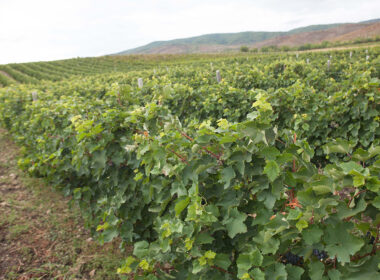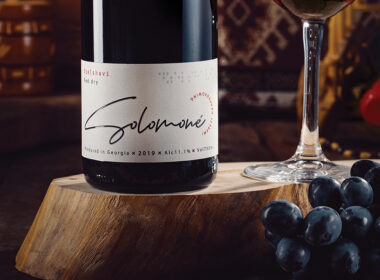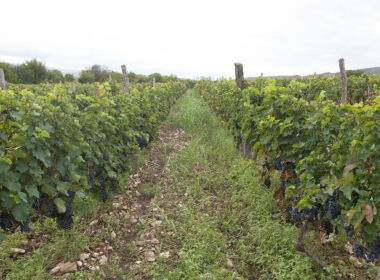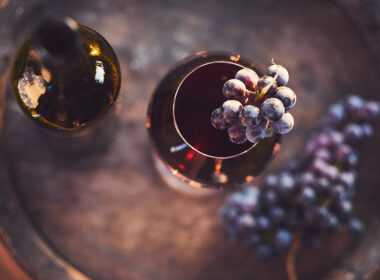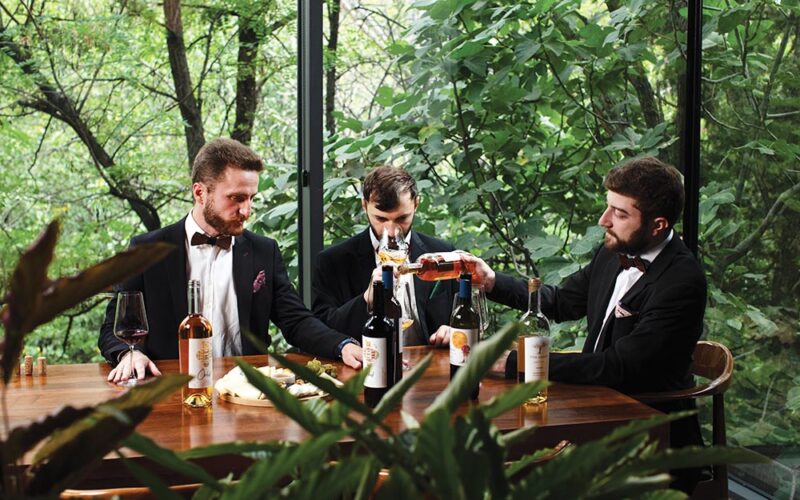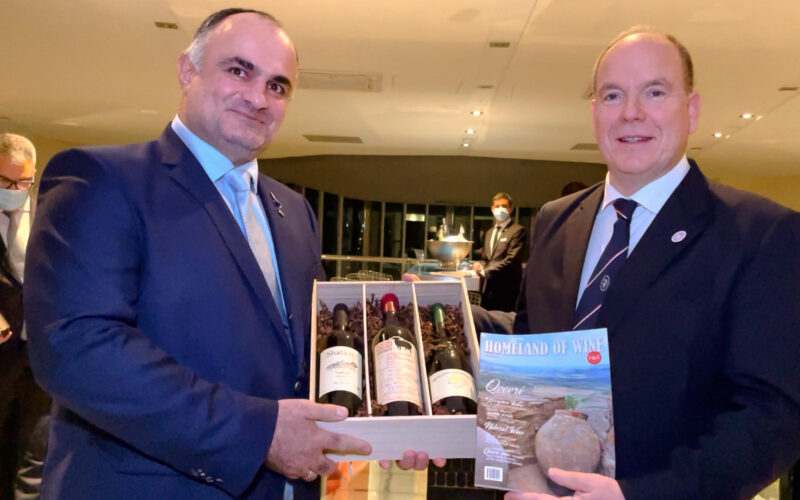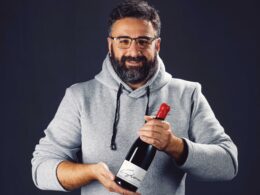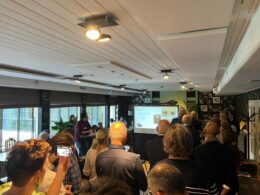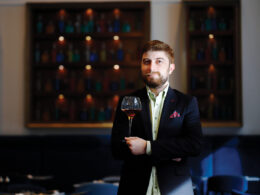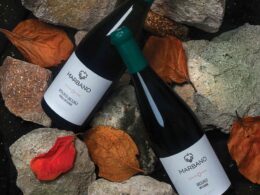შესავალი: „ჩვენ ვქმნით ღვინოს, რომელსაც ხედავთ, ეხებით, ყნოსავთ, აგემოვნებთ და შეიგრძნობთ თქვენი რეცეპტორებით, ამიტომ არის მნიშვნელოვანი ის ემოცია, რომელსაც ეს ღვინო გაჩვენებთ და გიყვებათ. ჩემი სახელია გიორგი სოლომნიშვილი, მე „ვწერ“ ღვინოს ჩემივე შექმნილი საღებავებით, ჩემივე მიწაზე მოყვანილი ყურძნით, მიწაზე, რომლის სუნი და გემოც კი ვიცი.
ღვინო ჩემი კომუნიკაციაა სამყაროსთან, საუბარი ბგერების გარეშე, როგორც ლოცვა გულში. მინდა, ჩემი ღვინო მომხმარებელს სულის შეძვრამდე უყვარდეს და ამისთვის თავად სულის დაღლამდე ვიღწვი.
ჩვენი ქვეყნის ისტორიაში მეღვინეობა და ღვინო უხსოვარი დროიდან აერთიანებს თაობებს. ის არის სიმბოლო ერთიანობისა და მარადიულობის. თანამგზავრია ქართველის ჭირშიც და ლხინშიც. ალბათ ღვინო ქართველის სინონიმიცაა, ანდა პირიქით – ქართველია ღვინის სინონიმი.
რაც შთამაგონებს არის მზე, წვიმა, ქარი და ღრუბელი ჩემი ვენახების თავზე. კლიმატი, რომელიც მოსავლის ხარისხს განაპირობებს და მკარნახობს შემდგომ ქმედებას. არაფერი განსაკუთრებული, უბრალოდ ვაზი უნდა შეიგრძნო და შეიყვარო, მერე კი ყველაფერს ისიც თავად გიკარნახებს.”
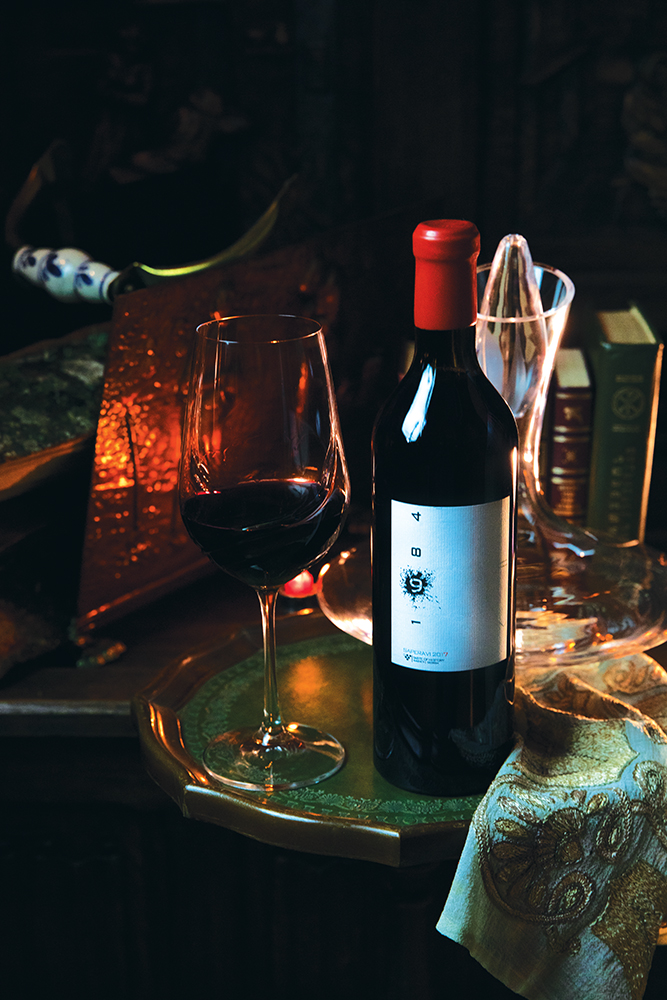
თავი პირველი: დაბადება
ყველა ღირსეულ ღვინოს სჭირდება ღირსეული წარსული: ღირსეული ნიადაგი და ღირსეული ვენახი.
დასაწყისშივე ვიცოდით, რომ ჩვენი ღვინოები ჩვენივე შეხედულებისამებრ უნდა შეგვექმნა, რისთვისაც საჭირო იყო გვქონოდა სრული კონტროლი ვენახზეც, მის მდებარეობაზეც და ყურძენზეც. ვიცოდით, რომ შესაძლებელია გააკეთო კარგი ღვინო, მაგრამ შეუძლებელია დააყენო დიდებული ღვინო დიდებული ვენახის გარეშე. და ვერც მხოლოდ ბუნებაზე ვიქნებოდით დამოკიდებული – გამოიმეტებდა თუ არა კარგ ამინდებს. მთავარი გადაწყვეტილება ყოველთვის იყო და არის ჩვენზე – რამდენად დავტვირთავთ ვენახს, როგორ მოვეპყრობით და ვუწამლებთ წლის განმავლობაში, – გვიყვება გიორგი აქ, თელავში, მუსხელიშვილის #22-ში, მამისეულ სახლში, რომლის ნუმერაციაც და გარემოც მისთვის განსაკუთრებული დატვირთვის და ამავე დროს, თავისებური ტვირთის მატარებელია.
ვენახები, სადაც მოყვანილი ყურძნისგან „სოლომნიშვილის მეღვინეობის“ რჩეული ღვინოები იბადება, კახეთში სხვადასხვა სოფელშია გაშენებული. ერთ-ერთი ვაზისუბანია, საიდანაც თავად მეღვინეა წარმოშობით. ამბობს: ვაზისუბანში ჩვენი ვენახები ალაფიანში, ანაქალოსახოზე და არხილაანთკალოზეა (ამ მიწებს სოფლის მოსახლეობა ასეთი სახელწოდებებით მოიხსენიებს). ეს დანალექი ნიადაგები, სადაც დიდი ხნის უკან წყალი იდგა, მდიდარია თიხოვანი სტრუქტურით, კირქვით, რაც წითელ ღვინოში განსაკუთრებით დადებითად აისახება და საშუალებას იძლევა, მასში ბევრად დიდხანს შენარჩუნდეს ფერის პიგმენტები. შედეგად ღვინო არომატებით მდიდარი და სხეულიანი გამოდის. ვაზისუბნის გარდა, ვენახები მუკუზანში, შალაურში, თელავსა და ვარდისუბანში გვაქვს.

თავი მეორე: ზრდა
ვაზთან ურთიერთობისას არ აქვს მნიშვნელობა რომ შენ მეტყველი ხარ, ის კი უტყვი. ამ ურთიერთობაში ეს ბარიერი წაშლილია. ვაზი იმდენად მიყვარს და იმდენად არის ჩემი ნაწილი, რომ როდესაც სეტყვა მოდის და მოსავალი ნადგურდება, სულში გაუსაძლისი ტკივილი ისადგურებს და ეს ტკივილი დროში უსასრულოდ იწელება.
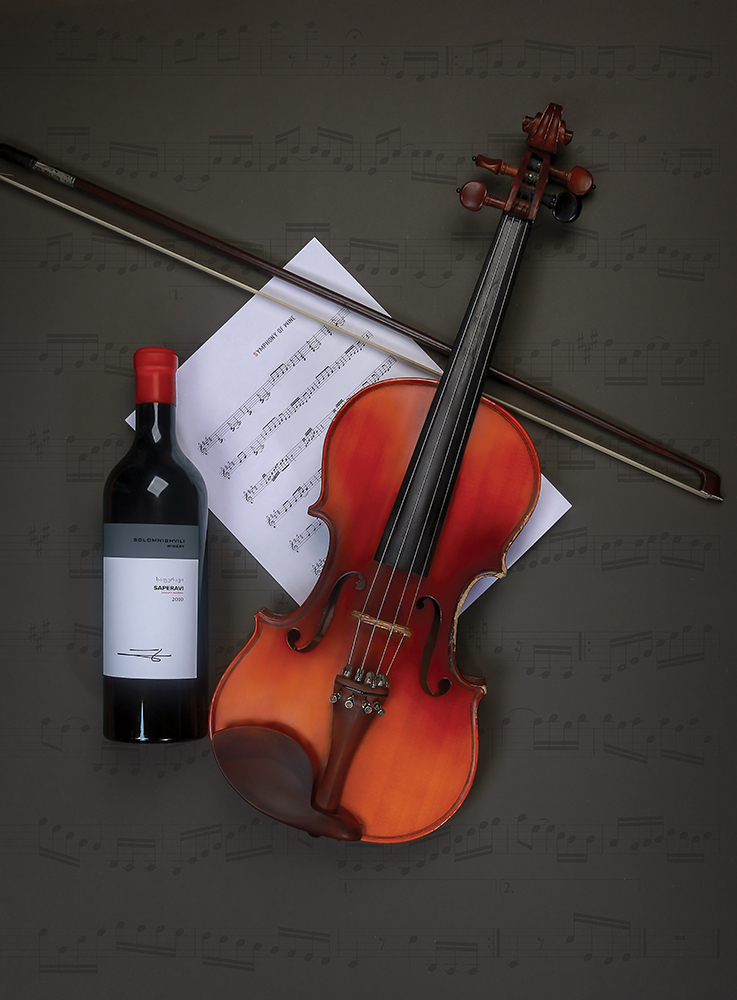
როდესაც ვაზს დარგავ, არ ნიშნავს, რომ რამდენიმე წელიწადში სრულყოფილ მოსავალს მოგცემს. მოსავლიანი ის მხოლოდ მეოთხე-მეხუთე წლიდან ხდება, მაგრამ არც მაშინაა მზად დიდი ღვინოებისთვის, რადგან ფორმირება არ აქვს დასრულებული. სწორედ ამან გადაგვაწყვეტინა ახალი ვენახების გაშენების ნაცვლად, უკვე არსებული შეგვეძინა და ასეც მოვიქეცით. გვაქვს 25, 35 და 45 წლის ვენახები და ყველაზე ასაკოვანი – 85 წლის ვენახი, რომელიც მცირე, მაგრამ ძალიან საინტერესო მოსავალს გვაძლევს და მისგან ყოველ წელს 2500-3000 ბოთლ ღვინოს ვაყენებთ, – ამბობს გიორგი. ამ ეტაპზე, ამავე ვენახის 2008 და 2010 წლის მოსავლისგან წარმოებული „სოლომნიშვილი“ უკვე იყიდება როგორც ქართულ, ისე ევროპისა და ამერიკის ბაზრებზე. მეღვინეობის წლიური წარმადობა 15-20 000 ბოთლია. ექსპორტზე ღვინოები იაპონიაში, ლიტვაში, ლატვიაში, საფრანგეთში, მონაკოში, იტალიაში, ინგლისში, ჰოლანდიაში, ბელგიაში, დანიაში, ჩეხეთსა და აშშ-ში გადის.
მერვე კლასში იყო. ვერ იხსენებს, გაესინჯა თუ არა მანამდე საფერავი, როგორც ყურძენი. ან იქნებ გასინჯულიც ჰქონდა და არ იცოდა, რომ ეს საფერავი იყო. ასეა თუ ისე, მერვე კლასში, შემოდგომისას, რთვლის პერიოდში, ვაზისუბანში მოხვდა. გზად სატვირთო მანქანა გაჩერდა, საფერავით დატვირთული. მანქანაზე აძვრა, დაუკითხავად აიღო ერთი მტევანი და შეჭამა. ყურძენმა საოცარი გემო და ის მნიშვნელოვანი შთაბეჭდილება დაუტოვა, რომელიც მეხსიერებაში სამუდამოდ დარჩა და მომავალში მეღვინის გზა განსაზღვრა. მომავალში ამას ბორდოთი და ბორდოს ღვინოებით შთაგონებაც დაემატა. დღეს, „სოლომნიშვილის მეღვინეობის“ ყველა ღვინო მხოლოდ საფერავის ჯიშის ყურძნისგან იწარმოება. გიორგი ამბობს, რომ ამ მიმართულების შეცვლას არ აპირებს, თუმცა წინადადებას ღიმილით ასრულებს: „არასოდეს თქვა არასოდეს“.
თავი მესამე: გამოსვლა
თუ შევთანხმდებით, რომ მიწა მამაა – დაკოჟრილი სტრუქტურით, გვალვასთან თუ წვიმასთან გადატანილი ომისგან დახეთქილი, ხვნით და გამარგვლით დაღლილი, მაშინ ვაზი დედაა, რომელმაც ნაყოფი უნდა შვას. ამაზე რომ ფიქრობ, ხვდები, ღვინო მხოლოდ ნასწავლი პროფესია კი არა, ის სილამაზეა, რომელმაც თავიდან ბოლომდე უნდა მოგიცვას.
ვაზის ნაყოფს ქართველები მტევანს ვეძახით. ადამიანის ხელის დაბოლოებაც მტევანია. ამ ორის კავშირი ცალკე საოცრებაა: ვიდრე ნაყოფი დედას მოსწყდება და თავის მშფოთვარე გზას გაივლის, მანამდე მას ადამიანის ხელი უნდა შეეხოს. ორი მტევნის შეხება ხელის ჩამორთმევაა, რას მისალმებას ნიშნავს. სწორედ ეს პირველი კავშირია ჩემთვის განსაკუთრებით საინტერესო და ნიშანდობლივი.

გიორგის ვენახებში რთველი უმეტესად გვიან იწყება – სექტემბრის ბოლოს ან ოქტომბრის დასაწყისში. ყურძნის გადამუშავებაც მარანში დაუყოვნებლივ ხდება, რის შემდეგაც იწყება მძვინვარე პროცესი – დუღილი. ქართველებს გვაქვს ასეთი სიტყვები: დაბადება და შობა. ნაყოფი ადრეულ გაზაფხულზე იბადება, თუმცა ვაზში გვიან შემოდგომაზეც არის მომავალი წლის ჩანასახი. შობა კი მოვლინებაა ამქვეყნად: ყურძენში დაგროვილი არომატები იშობა ღვინის სახით. ამ დროს ისე მეგობრდები ღვინოსთან, ისეთ მისტიკურ კავშირებს პოულობ, რომ მის დასაცავად მზად ხარ თავიც კი გაწირო.
თავი მეოთხე: დაყოვნება
გიორგის ვენახები ერთმანეთისგან მოშორებით მდებარეობს, რაც ძალიან ხელსაყრელია. რთველის თარიღებიც განსხვავებულია და ყურძენიც, რომელიც ყოველთვის სრულ სიმწიფემდე (და არა გადამწიფებამდე) მიჰყავს, 2.5-3 კვირიანი შუალედებით იკრიფება. ფერმენტაციის შემდგომ, რომელიც 2 კვირას გრძელდება, ღვინო 1-1.5 თვე ყოვნდება მყარ ნაწილაკებზე – წიპწა და კანი, კლერტიც, თუ ის ბოლომდეა დამწიფებული, რათა ღვინო ხავერდოვანი და ნაზი დადგეს.
მეორად დუღილს ღვინო ხშირად ქვევრში, ხანდახან კი ცისტერნებში გადის. შემდეგ ეს ახალგაზრდა ღვინომასალა ზამთრის სიცივეზე ყოვნება, რის შემდგომაც ნაწილი მუხის კასრებში გადადის მოსამწიფებლად. მეღვინეობის ადრეულ წლებში მუხასთან ნაკლები შეხება მქონდა – ამბობს გიორგი – უფრო ღვინისეული არომატები მიზიდავდა, მაგრამ მოგვიანებით ისე მოხდა, რომ მუხამ ძალიან შემაყვარა თავი და ჩემს ღვინოებში მისი ტონებიც გაჩნდა.
დაყოვნება, ეგალიზაცია – ამ ეტაპების გავლის შემდგომ ღვინო ბოთლებში გადადის და დამწიფებას რამდენიმე წლის განმავლობაში განაგრძობს (2.5 – 5 წლამდე, ხან კი 7 და 10 წლამდე), რის შემდეგაც გამოდის ბაზარზე.
თავი მეხუთე: გზა
ღვინო ჩემთვის არის ყველაზე ემოციური, ყველაზე ღრმა, ყველაზე ფილოსოფიური სასმელი.

#22
სოლომნიშვილის მეღვინეობის თითოეულ ვენახს, ისევე როგორც მათგან წარმოებულ ღვინოებს, თავისი სახელი აქვს. მაგალითად, #22-ის (იგივე „მამა“-ს) 2017 წლის და მომდევნო წლების ღვინო ერთი და იმავე ვენახიდან – #22-დან მიღებული მოსავლისგან არის წარმოებული.
გიორგი გვიყვება: #22 ვენახი ვაზისუბანში გვაქვს, საიდანაც ვართ კიდეც წარმოშობით. თელავის ეს მამისეული სახლიც, სადაც ახლა ვიმყოფებით, მუსხელიშვილის 22 ნომერია (გიორგის მამა ტრაგიკული შემთხვევის შედეგად გარდაიცვალა). მახსოვს, ერთ დღეს, ვიჯექი და ფურცელზე სიტყვა „მამა“-ს ვწერდი. „მ“ და „ა“ ისე გადავაბი, რომ 2-ანად წავიკითხე. მერე გამახსენდა, სკოლაში სწავლისას ორიანს სწორედ ასე ვწერდი – „კუდით“. უცებ დავიჭირე კავშირი ამ ორ შორის და დავიწყე ბევრი ორიანის და ბევრი „მა“-ს წერა. შემდეგ, დიზაინში „მა“-ს დუბლირება გავაკეთეთ და მივიღეთ კიდეც ეს სახელწოდება, რომელიც ეტიკეტზე 22-ადაც იკითხება და „მამა“-დაც. წინ დავურთეთ ნიშანი – #, რომელიც ჩემთვის დედამიწასთან, ამ დიდ და ლურჯ ციხესთან ასოცირდება, რომელსაც ერთხელ ყველა ვტოვებთ და სამუდამოდ ვთავისუფლდებით. ჩემსა და მამას შორის ეს ტყვეობაა, სხეულის ტყვეობა. მამა უკვე თავისუფალია. ხოლო როცა ჩემი გათავისუფლება მოხდება, მაშინ ისევ ერთად ვიქნებით.
ვაზისუბანში გიორგის კიდევ ერთი, 45 წლის ვენახი აქვს – „გელასი“. ამავე სახელწოდების ღვინოსაც აყენებს. მამის გარდაცვალებიდან ერთი წელიც არ იყო გასული, შვილი შეეძინა, რომელსაც მამამისის სახელი დაარქვა. ამ ვენახში მხოლოდ 10 რიგია, მაგრამ ათჯერ მეტია გიორგის სურვილი, უმცროსი გელაც მეღვინეობას გაჰყვეს. ფიქრობს, რომ ამაში ეს ვენახი აუცილებლად დაეხმარება.
Revolution
ეს წითელი მშრალი ღვინოა, სრულსხეულიანი, ხავერდოვანი გემოთი, რომლის ეტიკეტზე არსებულ წარწერას თუ R-ს ჩამოვაშორებთ, Evolution/ევოლუციას მივიღებთ, ხოლო თუ სარკისებურად შევხედავთ, LOVE-საც (სიყვარული) ამოვიკითხავთ. „რევოლუშენის“ ვენახი ქინძმარაულის მიკროზონაშია გაშენებული. ამ მიწებიდან მოყვანილი ყურძნისგან ტრადიციულად, ნახევრად ტკბილი ღვინოები მზადდებოდა, თუმცა გიორგი ამჯერადაც მშრალი ღვინის მიმართულებით წავიდა.
„ჩვენ“ და „1984“
ამ ღვინოებს ადგილობრივი და უცხოელი მომხმარებელი კარგად იცნობს. ორივე ვენახი სოფელ შალაურში (თელავთან) ერთმანეთისგან 400 მეტრის დაშორებით მდებარეობს.
„1984“-ს ვენახში ბუდეშური საფერავია გაშენებული. ეს ჯიში სიმწიფეს შედარებით ადრე აღწევს. „ჩვენ“ – საფერავის ჯიშის ვენახია, 35 წლის.

„მადლობა“
დროსთან ყოველთვის მარცხდები, მაგრამ მთავარია, არ დაეცე და შეტაკებებში მაინც სძლიო…. სძლიო საკუთარ თავს. შვილის – გელას დაბადებამ ჩემს ცხოვრებას ახალი ძალა შეჰმატა. დღეს უკვე ერთად ვფუსფუსებთ მარანში. ერთ დღესაც, შევთავაზე ღვინო ერთად გაგვეკეთებინა „როგორც ჩემი და შენი“ და ამ ღვინოს დავარქვით „მადლობა“. ეს მადლობა ორნაირიად შეიძლება გავიგოთ – ჩემგან ჩემი მამისა და ჩემი შვილის მიმართ და ჩემი შვილისგან ჩემს მიმართ, რაც ავსახეთ კიდეც ეტიკეტსა და კონტრეტიკეტში.
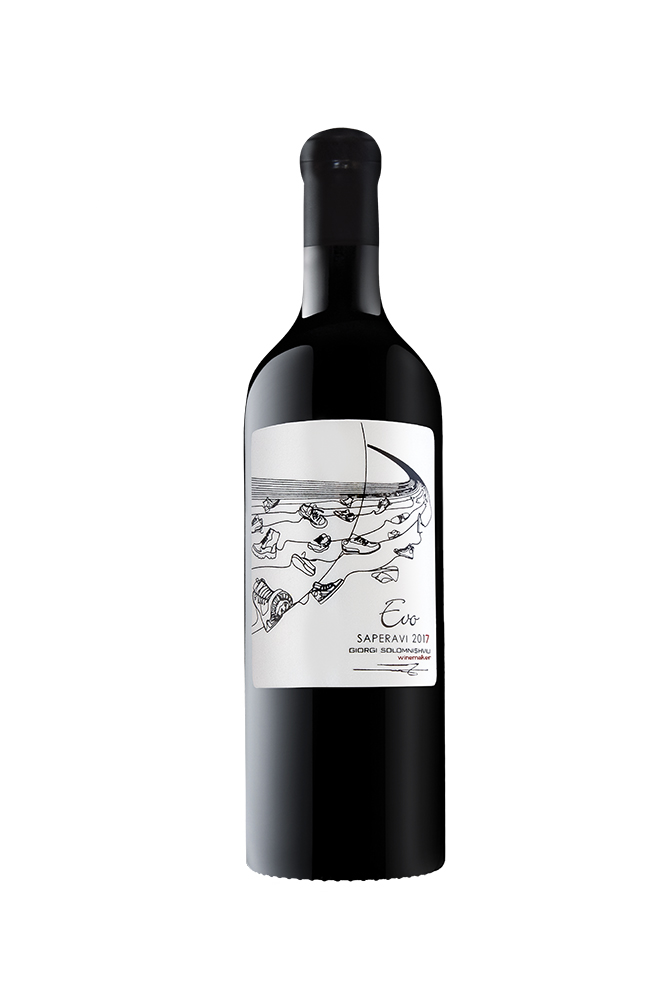
ეპილოგი
ტრადიციულად, ყოველ წელს, ერთი და იმავე ვენახიდან, ერთი და იმავე ვაზიდან იბადება ახალი დედ-მამიშვილი წინა წლების მოსავლისა. ძველად, საქართველოში ახალ წელს რთველის წინ – სექტემბრის საწყისში აღნიშნავდნენ. ჩვენთან დრო სწორედ რთვლიდან რთვლამდე – სექტემბრიდან სექტემბრამდე იზომება, ნიშნად იმისა, რომ ახლიდან გასავლელია ვენახში წინა წლის გზა, წინა წლის ნაბიჯები.
Giorgi Solomnishvili: I create wine using brushes that are the grapes from my land, grown on the soil that I know all too well.

Introduction
Our wine breathes. All of your senses, including sight, touch, smell, and taste, can detect it. We understand the significance of the feelings our wines awake. My name is Giorgi Solomnishvili and I create wine using brushes that are the grapes from my land, grown on the soil that I know all too well.
Wine is how I communicate with the world. It is speaking without words, like a prayer in your heart. I want every single one of my customers to fall deeply in love with my wine and I am prepared to give it my all.
Wine connects generations throughout the history of our country. It is the symbol of unity and eternity. It is our companion in good times and the bad. Wine is a synonym for “a Georgian”, or better yet, “a Georgian” is a synonym for wine.
The Sun, rain, wind, and clouds above my vineyard are what inspire me. It is the climate that determines the quality of the harvest and guides my every move. It is astonishingly simple: fall in love with the vine and it will guide you through.
Chapter 1: The birth
All noble wine needs a noble past – a noble soil and a noble vineyard.
We knew from the start that our wine would be made in our way. To do that, we had to have full control over the vineyard, its location, and the grape. We knew it was possible to make good wine, but we also knew that it is impossible to make grand wine without a grand vineyard. We couldn’t simply leave it up to nature and hope for better days. We left the key decisions up to us. We decide the load of the vineyards, its treatment, and particular care, – says Giorgi as he hosts us in his home, in Telavi, on 22, Muskhelishvili street. The street number and the environment carry a special meaning for him, all the while representing his burden of duty.
The vineyards that make the selected wine of “Solomnishvili Winery” are located in different villages of Kakheti. One of them is situated in Vazisubani, the winemaker’s place of origin. “Our vineyards in Vazisubani are in Alapiani, Anakalosakho, and Arkhilaantkalo (names the locals use to refer to these lands). These sedimentary soils, once overflowing with water, are rich in clay structure, and limestone, which have a particularly positive effect on red wine and allow it to retain its color pigments for a longer time. As a result, the wine is rich in aromas and full-bodied. In addition to Vazisubani, we have vineyards in Mukuzani, Shalauri, Telavi, and Vardisubani”.
He was in the 8th grade. He can’t remember if he tried Saperavi as a grape before. He might have tried it but did not have the knowledge of it being Saperavi. Whatever the case may be, during the Autumn of his 8th grade, he found himself in the harvest (Rtveli) in Vazisubani. He watched a lorry, loaded with Saperavi stop by. Without any permission, he climbed atop the vehicle, took a whole bunch of a Saperavi grape, and gave it a try. The grape left an amazing taste and an important impression that remained in his memory forever and determined the path of the winemaker in the future. He was later further inspired by Bordeaux and Bordeaux wines. Today, all “Solomnishvili Winery” wines are produced only from Saperavi grapes. Giorgi says that he is not planning to change his approach, but smiles as he says: “Never say never.”

Chapter 2: Growth
When dealing with vine, it doesn’t matter that you can speak and it is speechless. In this relationship, this barrier is removed. I love the vine dearly; it is so much a part of me that when the hail comes and the harvest is destroyed, an unbearable pain settles in my soul that stretches endlessly in time.
When you plant a vine, you have to understand that it will not yield a perfect harvest in a few years. It yields better results in its fourth or fifth year, however, even then, it is not ready to make great wines, because its formation is incomplete. This is what made us decide to buy existing vineyards. We have 25-, 35- and 45-year-old vineyards. Our oldest one is 85 years old. It gives us a small but very interesting harvest and we produce from 2500 to 3000 bottles of wine from it every year. – says Giorgi. Today, “Solomnishvili” produced from the 2008 and 2010 vintages of the above-mentioned vineyard is already sold on the Georgian, European and American markets. The annual production of the winery is 15-20,000 bottles. Wines are exported to Japan, Lithuania, Latvia, France, Monaco, Italy, Great Britain, Holland, Belgium, Denmark, the Czech Republic, and the USA.
Chapter 3: Exodus
If we agree that the soil is The Father – with the calloused hands, torn by the war with drought or rain, tired of plowing and weeding, then the vine is The Mother that shall bear the fruit. If you think about that, you realize that winemaking is merely a learned profession – it is the beauty that should permeate all of your being.
Georgians call the fruit of the vine “mtevani”. The end of the human hand is also “mtevani”. The connection between the two is a special wonder: before the fetus leaves its mother and goes on its turbulent path, it must be touched by a human hand. The touching of two hands is a handshake, a greeting. This first connection is especially interesting and significant for me.
The harvest usually starts late in Giorgi’s vineyards, – at the end of September or the beginning of October. Grapes are immediately processed in the cellar, after which the intense process of fermentation begins. Georgians have two words: birth and nativity. The vine bears the fruit in early Spring, but up until late autumn, it still contains the germ of the next year’s one. Nativity is the appearance in this world: the aromas accumulated in the grapes are nascent in the wine. At this point, you befriend the wine, and make mystical connections with it, so much so that you are prepared to die to protect it.

Chapter 4: Ageing
Giorgi’s vineyards are conveniently located far from each other. The harvest dates are different and the grapes, which are always brought to full ripeness (not overripeness), are picked at intervals of 2.5-3 weeks. After fermentation, which lasts for 2 weeks, the wine is left for 1-1.5 months on the hard parts – the skin and pip, and the stalk, if it is fully ripe, so that the wine can become velvety and tender.
The wine undergoes secondary fermentation in qvevri or cisterns. Then, some of this young wine material is moved to oak barrels to mature during the winter months. In the early years of winemaking, I didn’t have a lot of contact with oak, – says Giorgi – I was more attracted to pure aromas of wine, but as it happens I later fell in love with oak and its tones appeared in my wines.
Ageing, assamblage – after these stages, the wine goes into bottles and continues to mature for several years (up to 2.5 – 5 years, and sometimes up to 7 and 10 years), before being released on the market.
Chapter 5: The Road
The most sentimental, intellectual, and deep beverage for me is wine.
#22
Each “Solomnishvili Winery” wine has its name, which corresponds with the vineyard it was made from. For example, wine #22 (also known as “Mama”) is produced from the vineyard with the same name – #22.
Giorgi continues his story: “Vineyard #22 is in Vazisubani, our place of origin. My father’s house in Telavi, where we are now, is situated at 22, Muskhelishvili street (Giorgi’s father died as a result of a tragic accident). I remember one day, I was sitting and writing the word “father” (“Mama” in Georgian) on a piece of paper. I connected “M” and “A” so that it read as the number 2. Then I remembered that when I was studying at school, I used to write the number 2 just like that – “with a tail”. I suddenly caught the connection between the two and started writing a lot of 2’s and a lot of “ma”. Then, we duplicated the “Ma” in the design and got this name, which is read as 22 as well as “Mama” on the label. We added the sign – #, which I associate with the Earth, this big blue castle that we all leave once and are freed from forever. There is certain captivity between me and my father – captivity of the body. My father is already free. And when I am released, then we will be together again.”
Giorgi has another 45-year-old vineyard in Vazisubani – “Gelasi”. He also produces wine of the same name. Less than a year after his father’s death, his son was born, whom he named after his father. There are only 10 rows in this vineyard, and Giorgi’s wish is tenfold: that Gela junior will also follow in his footsteps and become a winemaker. He thinks that this vineyard will help.

Revolution
This is a full-bodied, dry red wine, with a velvety taste. If we remove the “R” from its name, we will be left with Evolution, the mirror image of the label will reveal the word “LOVE”. “Revolution” vineyard is planted in Kindzmarauli microzone. Traditionally, semi-sweet wines were made from the grapes grown in these lands, but Giorgi went in the direction of dry wines.
“US” (Chven) and “1984”

These wines are well known to both local and foreign consumers. Both vineyards are located 400 meters away from each other in Shalauri village (near Telavi). The “1984” vineyard is populated by Budeshuri Saperavi. This variety reaches maturity relatively early. “US” is a 35-year-old vineyard of the Saperavi variety.
“Madloba“
Time defeats us in the end, but it is important to stand tall and win the small battles…Win over yourself. The birth of my son Gela added new strength to my life. Today we are already rummaging in the cellar together.
One day, I suggested that we make wine together “like mine and yours” and we named this wine “Madloba” (“Thank you” in Georgian). This gratitude can be understood in two ways – from me to my father and my son and from my son to me, which was also shown in the label and its counter label.
Epilogue
A new sibling is typically born from the harvest of the previous year, from the same vineyard, from the same vine. In Georgia’s early history, the New Year was celebrated at the start of September, before the harvest. As a reminder that the previous year’s journey and steps in the vineyard must be repeated, time is measured for us from harvest to harvest, or from September to September.

